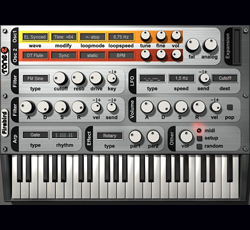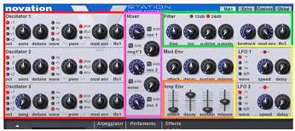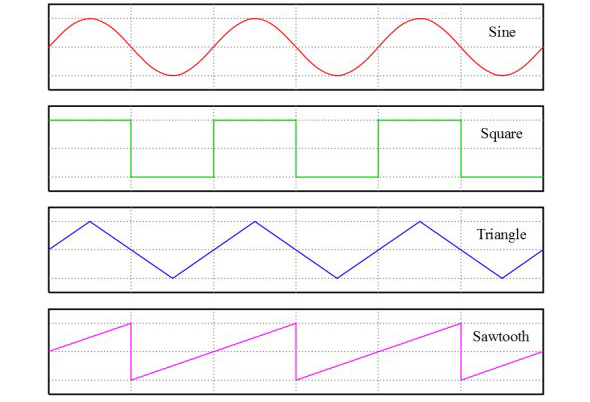When you first look at a synthesizer, it can be a little intimidating with all the knobs and switches and buttons.
Believe it or not, most synthesizers have the same blocks of components, and once you figure out what they do, you can pretty much use any synthesizer.
The main components you’ll find in a synthesizer:
—Oscillators (Red)
—Mixer (Pink)
—An Envelope Generator (Orange)
—LFO (Yellow)
—Filter (Green)
Additionally you’ll usually find options for:
—Polyphony
—Arpeggiator
—Effects
—Ring Modulation
—Noise Generator
—And More
I’m not going to attempt to cover all that at once, this lesson will cover just a few of these.
Oscillator Section
An oscillator is an electronic circuit that creates a repetitive signal. There are four basic wave shapes that an oscillator will produce.
—Sine Wave
—Triangle Wave
—Square Wave
—Sawtooth Wave
A sine wave is a single tone with no harmonics. The waveform has round peaks and troughs and smoothly changes from positive to negative polarity. This is a boring sound on its own, but is essential for creating certain sounds.
Here is the sound of a sine wave from a synthesizer. (Listen)
A triangle wave adds odd harmonics to the sine wave. This makes the waveshape linearly alternate positive and negative.
Here is the sound of a triangle wave from a synthesizer. (Listen)
A square wave has only odd harmonics, like the triangle wave. It has instantaneous transitions between high and low levels. Here is the sound of a square wave from a synthesizer. (Listen)
A Sawtooth wave is named for it’s resemblance to the teeth of a saw. There is a linear rise to the highest value then an instant drop to the lowest level. A sawtooth wave contains both odd and even harmonics. Here is the sound of a sawtooth wave from a synthesizer. (Listen)
Because the square wave and sawtooth wave shapes are rich in harmonics, they are a good starting point for creating sounds. Any one of these wave shapes on their own is not enough to make really interesting sounds which is why you’ll usually find two or more oscillators in a synth.
Mixer Section
You control the blend of the multiple oscillators and other sound generators in the synth in the mixer section. This is most often just a simple knob for each oscillator, turn up the ones you want to hear.
More Oscillator Controls
In addition to the wave shape part of the oscillator section there are also some controls you should be aware of.
There is usually an octave selection for selecting which range the oscillator operates in. There are also pitch controls, usually a semitone adjustment and a fine tune or sometimes labeled detune control.
Here is what it sounds like when you take two identical oscillators set to sawtooth and slightly detune one. (Listen)
The oscillator section may have some other controls for envelopes and LFOs, but I’ll come back to those in another lesson.
I invite you to open up all of your virtual synths and locate the common components. Experiment with combining the various wave shapes and get to know how each one sounds.
Now let’s have a look at the envelope and filter sections.























